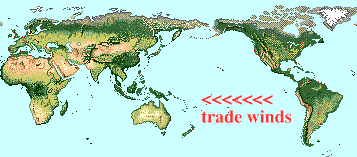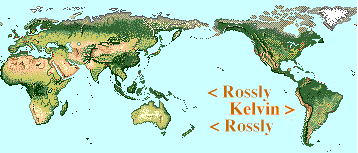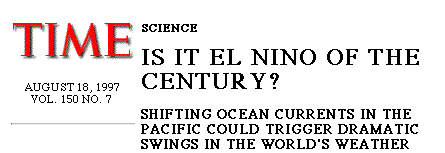

TIME SCIENCE HEADLINE
El Nino
What is It?
El Nino or, more accurately, El Nino- Southern Oscillation (ENSO) is a fascinating weather phenomenon of global importance. El Nino is large scale interaction between the ocean and the atmosphere. It is a periodic event that occurs every three to five years. During an El Nino the marine life along the Pacific coast of South America suffers starvation and death and the South American coastal states experience heavy rainfall and flooding. At the same time Central America, South East Asia, Africa and Australia experience extremely dry weather and drought. Large scale (millions of acres) of brush and forest fires have been known to occur in Australia and the adjacent islands. Flooding is common not only in the Eastern Pacific states of South America but also in the Southern and Western United States and in Western Europe. In the Northern United States El Nino causes abnormally mild winters.
Scientifically, the El Nino phenomenon is a demonstration of large scale terrestrial physics. Large scale movements of water and air cause and are caused by temperature and pressure differential between the two Pacific coasts. Modern satellites are beginning to provide the temperature and pressure data needed to analyze this intricate interaction.
Why is it called El Nino?
El Nino (pronounced el neenyo) is Spanish for male child. During the Christmas season the word also refers to Baby Jesus. Years ago the fishermen along the coasts of Peru and Equador observed that periodically, at Christmas time, a warm current appears in the Pacific ocean and lasts for several months. At the same time heavy rains often cause massive flooding. The result is heavy loss of fish and water birds. The South American fishermen named this warm current El Nino because of the timing of its occurrence..
The Physics of El Nino.
El Nino is caused by a periodic disruption of the normal water and air movements across the Pacific. In normal (non El Nino) years the prevalent surface winds across the Pacific are the Trade Winds. Trade winds blow across the Pacific from East to West.
 They drag with them warm surface water. The ocean surface temperature in Indonesia is about 15 degrees Fahrenheit warmer that the water surface temperature along the coast of Peru. The sea surface in Indonesia is about two feet higher than it is in South America. The movement of the surface water away from the coast the colder ocean water to come up to the surface. The colder water is rich in nutrients which support abundant marine life. But at the same time, under the surface of the ocean, large underwater waves (called the Kelvin and Rossby waves) also move water across the Pacific. The Kelvin waves move the water eastward. These waves propagate along the equator. They return the warm water back to South America where it mixes with the cold currents of Peru and Equador. The waves then fork North and South and curve westward to begin the return trip.
They drag with them warm surface water. The ocean surface temperature in Indonesia is about 15 degrees Fahrenheit warmer that the water surface temperature along the coast of Peru. The sea surface in Indonesia is about two feet higher than it is in South America. The movement of the surface water away from the coast the colder ocean water to come up to the surface. The colder water is rich in nutrients which support abundant marine life. But at the same time, under the surface of the ocean, large underwater waves (called the Kelvin and Rossby waves) also move water across the Pacific. The Kelvin waves move the water eastward. These waves propagate along the equator. They return the warm water back to South America where it mixes with the cold currents of Peru and Equador. The waves then fork North and South and curve westward to begin the return trip.

The returning waves are called the Rossby waves.
The Rossby waves travel much slower than the Kelvin waves. Since the Kelvin waves transport warm water eastward at a faster rate than the Rossby waves bring it back an imbalance occurs which periodically weakens the trade winds. As the trade winds weaken, the surface temperature of the sea water along the coast of South America rises and the sea level atmospheric pressure decreases. This causes further weakening of the trade winds. The water temperature along the South American coast rises causing more evaporation and increased precipitation. At the same time the upswell of the colder water slows down and the fish get less food. On the other side of the Pacific the ocean temperature drops resulting in overall drier weather. A complicated chain of events starts to alter the weather around the globe. Another El Nino has formed.
For further reading follow these links:
1.  2.
2.  3.
3. 
 Extra Credit Question:
Extra Credit Question:
Why do the Rossby waves travel more slowly than the Kelvin waves?
To get the extra credit send an email message with your answers to Prof. Novak
©1998 IUPUI, all rights reserved.







 2.
2.  3.
3. 
 Extra Credit Question:
Extra Credit Question: